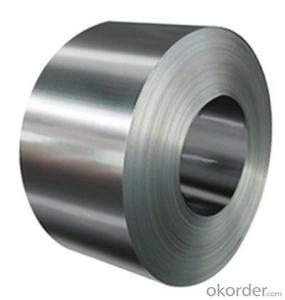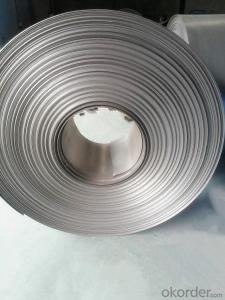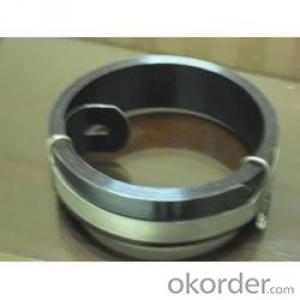Stainless Steel Decorative Coil / Sheet
- Loading Port:
- China Main Port
- Payment Terms:
- TT or LC
- Min Order Qty:
- 20 Ton m.t.
- Supply Capability:
- 20000 ton per month m.t./month
OKorder Service Pledge
OKorder Financial Service
You Might Also Like
Stainless Steel Decorative Coil / Sheet
1.Size: Thickness: 0.3mm ~~ 20mm, Width: 50mm ~~ 1250mm, Length: to be customized.
2.Material:SUS201,202,301,304,304L,316,316L ,321 etc.
3.Standard:AISI,JIS,GB,DIN
4.Finish:mirror, hair line, sand blast, etched, embossed, linen, checkered, tear, golden mirror,
5.Testing:Each heat number and batch must be tested for both chemical and mechanical properties
|
Stainless Steel Coil / Sheet | |
|
Standard |
JIS, AISI, ASTM, GB, DIN, EN |
|
Property |
Stainless steel coil, Stainless steel sheet, Stainless steel plate, stainless steel |
|
Length |
1-12m |
|
Quality |
prime |
|
Manufacturing Process |
factory direct sale |
|
Surface Treatment |
mirror, hair line, sand blast, etched, embossed, linen, checkered, tear, golden mirror, |
|
Main Grade |
201,201,301,302,303,304,321,316,316L,309,310,309H, 310S,431,430,420,430F |
|
MOQ |
20 ton |
|
Trade Term |
FOB China mainport |
|
Payment term |
T/T or L/C |
|
Price |
negotiable |
|
Packing |
Export packing |
|
Dilvery time |
20days or depend on order quantity |
|
Container |
The capacity for a 20" container:20-24tons |



- Q: 301 stainless steel belt and 304 stainless steel belt, which quality is good?
- You can be responsible to tell you, 304 to better stainless steel, the amount of nickel will be on the 304 to more than 301
- Q: What are the standard dimensions of stainless steel strips?
- The specific application and industry requirements can cause the dimensions of stainless steel strips to vary. Nonetheless, there are commonly used standard dimensions. Stainless steel strips are typically available in a range of widths, from 0.025 inches to 24 inches. The thickness of these strips can vary from 0.001 inches to 0.1875 inches. Lengths can also differ, but standard lengths are commonly found in coils or rolls that can reach up to 100 feet. It is worth mentioning that these dimensions are adjustable and can be tailored to suit the project or application's specific needs.
- Q: How do you prevent corrosion fatigue of stainless steel strips?
- Corrosion fatigue of stainless steel strips can be prevented by implementing various measures such as proper surface preparation, avoiding exposure to corrosive environments, using corrosion inhibitors, applying protective coatings, and maintaining appropriate stress levels within the material. Regular inspections and maintenance can also help identify and address any potential issues before they escalate.
- Q: Are 111 stainless steel strips suitable for pressure vessels?
- No, 111 stainless steel strips are not suitable for pressure vessels.
- Q: Can 111 stainless steel strips be coated with anti-fouling coatings?
- Yes, 111 stainless steel strips can be coated with anti-fouling coatings. Anti-fouling coatings are specifically designed to prevent the accumulation of marine organisms, such as algae and barnacles, on surfaces exposed to water. Stainless steel is a commonly used material in marine applications due to its corrosion resistance and durability. By applying anti-fouling coatings, the strips can be protected from fouling, ensuring their longevity and performance in marine environments.
- Q: What is the weight of stainless steel strips?
- The weight of stainless steel strips can vary depending on their dimensions and thickness. Generally, stainless steel has a density of about 7.93 grams per cubic centimeter. To calculate the weight of a stainless steel strip, you would need to know its length, width, and thickness. By multiplying the area of the strip by its thickness and density, you can determine its weight.
- Q: How do stainless steel strips handle exposure to alkalis?
- Due to their strong resistance to alkalis, stainless steel strips are an ideal choice for applications that require exposure to such substances. The presence of chromium in stainless steel creates a protective layer on the surface, called a passive film, which acts as a barrier against corrosion and chemical attacks. This passive film effectively blocks alkalis from penetrating the steel, thereby safeguarding it against potential damage. Moreover, stainless steel's exceptional corrosion resistance and durability enable it to withstand prolonged exposure to alkalis without deterioration or loss of structural integrity. As a result, stainless steel strips are a dependable and enduring material for a wide range of industrial and commercial uses that involve alkalis.
- Q: Are 111 stainless steel strips suitable for decorative applications?
- Yes, 111 stainless steel strips are suitable for decorative applications.
- Q: What is the fatigue strength of stainless steel strips?
- Various factors, such as the specific grade of stainless steel, the surface condition, and the manufacturing process, can lead to variations in the fatigue strength of stainless steel strips. In comparison to other materials, stainless steel is generally recognized for its high fatigue strength. Stainless steel strips find common use in industries like automotive, aerospace, and construction, where they undergo cyclic loading or repetitive stress. The fatigue strength denotes the maximum stress level that a material can endure for a specific number of cycles without failure. To evaluate the fatigue strength of stainless steel strips, fatigue testing is often employed. This involves subjecting a strip specimen to repeated loading and unloading cycles until failure occurs. The results are then used to determine the material's endurance or fatigue limit, which signifies the stress level below which the material can withstand an infinite number of cycles without failing. The fatigue strength of stainless steel strips typically falls within the range of 150 to 500 megapascals (MPa), depending on the grade of stainless steel. However, it's important to note that the fatigue strength can be affected by various factors, including the surface finish, presence of defects or notches, temperature, and environmental conditions. In summary, stainless steel strips generally exhibit high fatigue strength in comparison to other materials. The specific fatigue strength can vary based on the grade of stainless steel and other influencing factors, and it is typically determined through fatigue testing.
- Q: Can stainless steel strips be used in power generation industries?
- Certainly! Stainless steel strips have a wide range of applications in the power generation sector. This alloy is known for its impressive resistance to corrosion and ability to withstand harsh conditions, making it a suitable material for various purposes. In power plants, stainless steel strips find their use in the construction of equipment like turbines, generators, and other components that are exposed to high temperatures, pressure, and corrosive environments. The corrosion-resistant properties of stainless steel ensure that these components remain intact and structurally sound over time. Moreover, stainless steel strips can be utilized in the fabrication of heat exchangers, condensers, and different piping systems within power plants. The excellent thermal conductivity of stainless steel allows for efficient heat transfer, making it an ideal choice for these applications. Furthermore, stainless steel's resistance to oxidation and scaling at high temperatures makes it ideal for use in boilers and steam generators, which are essential components of power generation systems. All in all, stainless steel strips offer numerous advantages, including corrosion resistance, durability, and high-temperature performance, making them a reliable option for the power generation industry.
1. Manufacturer Overview
| Location | Zhejiang,China |
| Year Established | 2010 |
| Annual Output Value | Above US$16Million |
| Main Markets | Japan, South America |
| Company Certifications | ISO9001:2000; |
2. Manufacturer Certificates
| a) Certification Name | |
| Range | |
| Reference | |
| Validity Period |
3. Manufacturer Capability
| a) Trade Capacity | |
| Nearest Port | Shanghai |
| Export Percentage | 60% |
| No.of Employees in Trade Department | 50 People |
| Language Spoken: | English;Chinese; Japanese |
| b) Factory Information | |
| Factory Size: | Above 80,000 square meters |
| No. of Production Lines | Above 8 |
| Contract Manufacturing | OEM Service Offered;Design Service Offered |
| Product Price Range | Average |
Send your message to us
Stainless Steel Decorative Coil / Sheet
- Loading Port:
- China Main Port
- Payment Terms:
- TT or LC
- Min Order Qty:
- 20 Ton m.t.
- Supply Capability:
- 20000 ton per month m.t./month
OKorder Service Pledge
OKorder Financial Service
Similar products
Hot products
Hot Searches
Related keywords




























